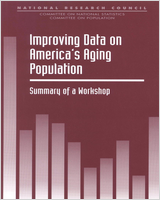NCBI Bookshelf. A service of the National Library of Medicine, National Institutes of Health.
The Committee on National Statistics and the Committee on Population, at the request of the NIA, convened a workshop in March 1996 to discuss data on the aging population that address the emerging and important social, economic, and health conditions of the older population. The purposes of the workshop were to identify how the population at older ages in the next few decades will differ from the older population today, to understand the underlying causes of those changes, to anticipate future problems and policy issues, and to suggest future needs for data for research in these areas. The scope of the workshop was broader than that of the 1988 CNSTAT report, including not only data on health and long-term care, but also actuarial, economic, demographic, housing, and epidemiological data needs for informing public policy.
Contents
- COMMITTEE ON NATIONAL STATISTICS 1995–1996
- COMMITTEE ON POPULATION 1995–1996
- WORKSHOP ON PRIORITIES FOR DATA ON THE AGING POPULATION
- Preface
- Introduction
- America's Aging Population: Trends and Uncertainties
- Improving Data Sources
- Conclusions
- References
- Appendix A Agenda
- Appendix B Data Sources for Studying Aging: Survey Characteristics and Linkage Capacities
This workshop was supported by funds from the National Institute on Aging through grant No. SES 9116694 by the National Science Foundation to the National Academy of Sciences for support of core activities of the Committee on National Statistics.
NOTICE: The project that is the subject of this report was approved by the Governing Board of the National Research Council, whose members are drawn from the councils of the National Academy of Sciences, the National Academy of Engineering, and the Institute of Medicine. The members of the committee responsible for the report were chosen for their special competences and with regard for appropriate balance.
This report has been reviewed by a group other than the authors according to procedures approved by a Report Review Committee consisting of members of the National Academy of Sciences, the National Academy of Engineering, and the Institute of Medicine.
The National Academy of Sciences is a private, nonprofit, self-perpetuating society of distinguished scholars engaged in scientific and engineering research, dedicated to the furtherance of science and technology and to their use for the general welfare. Upon the authority of the charter granted to it by the Congress in 1863, the Academy has a mandate that requires it to advise the federal government on scientific and technical matters. Dr. Bruce M. Alberts is president of the National Academy of Sciences.
The National Academy of Engineering was established in 1964, under the charter of the National Academy of Sciences, as a parallel organization of outstanding engineers. It is autonomous in its administration and in the selection of its members, sharing with the National Academy of Sciences the responsibility for advising the federal government. The National Academy of Engineering also sponsors engineering programs aimed at meeting national needs, encourages education and research, and recognizes the superior achievements of engineers. Dr. William A. Wulf is interim president of the National Academy of Engineering.
The Institute of Medicine was established in 1970 by the National Academy of Sciences to secure the services of eminent members of appropriate professions in the examination of policy matters pertaining to the health of the public. The Institute acts under the responsibility given to the National Academy of Sciences by its congressional charter to be an adviser to the federal government and, upon its own initiative, to identify issues of medical care, research, and education. Dr. Kenneth I. Shine is president of the Institute of Medicine.
The National Research Council was organized by the National Academy of Sciences in 1916 to associate the broad community of science and technology with the Academy's purposes of furthering knowledge and advising the federal government. Functioning in accordance with general policies determined by the Academy, the Council has become the principal operating agency of both the National Academy of Sciences and the National Academy of Engineering in providing services to the government, the public, and the scientific and engineering communities. The Council is administered jointly by both Academies and the Institute of Medicine. Dr. Bruce M. Alberts and Dr. William A. Wulf are chairman and interim vice chairman, respectively, of the National Research Council.
- NLM CatalogRelated NLM Catalog Entries
- How to anticipate the assessment of the public health benefit of new medicines?[Therapie. 2007]How to anticipate the assessment of the public health benefit of new medicines?Massol J, Puech A, Boissel JP, Participants inRound Table No 7, Giens XXII. Therapie. 2007 Sep-Oct; 62(5):427-35. Epub 2008 Jan 19.
- Review Improving Health Care Cost Projections for the Medicare Population: Summary of a Workshop[ 2010]Review Improving Health Care Cost Projections for the Medicare Population: Summary of a WorkshopNational Research Council (US) Committee on National Statistics. 2010
- Review Fostering Independence, Participation, and Healthy Aging Through Technology: Workshop Summary[ 2013]Review Fostering Independence, Participation, and Healthy Aging Through Technology: Workshop SummaryForum on Aging, Disability, and Independence, Board on Health Sciences Policy, Division of Behavioral and Social Sciences and Education, Institute of Medicine, National Research Council. 2013 Jul 19
- Making psychiatric epidemiology useful: the contribution of epidemiology to government policy.[Int Rev Psychiatry. 2003]Making psychiatric epidemiology useful: the contribution of epidemiology to government policy.Jenkins R. Int Rev Psychiatry. 2003 Feb-May; 15(1-2):188-200.
- Review Population risk factors and trends in health care and public policy.[J Acad Nutr Diet. 2012]Review Population risk factors and trends in health care and public policy.Haughton B, Stang J. J Acad Nutr Diet. 2012 Mar; 112(3 Suppl):S35-46.
- Improving Data on America's Aging PopulationImproving Data on America's Aging Population
Your browsing activity is empty.
Activity recording is turned off.
See more...
